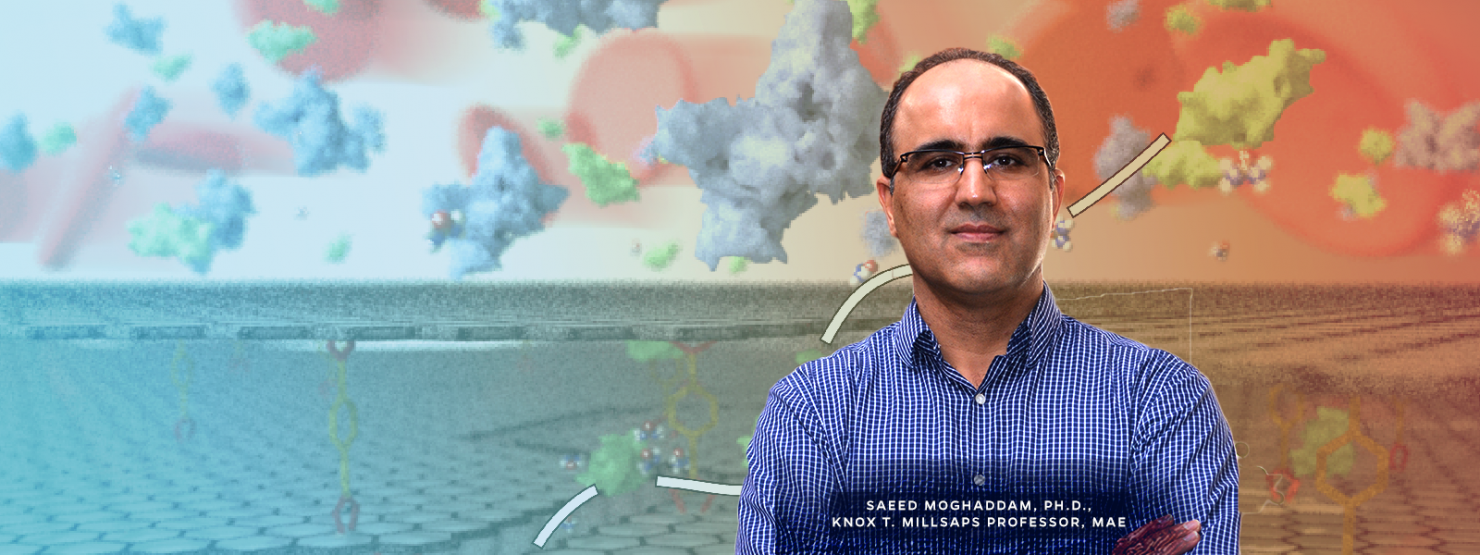Researchers from the Department of Mechanical & Aerospace Engineering (MAE) in the Herbert Wertheim College of Engineering have developed a new hemodialysis membrane made of graphene oxide (GO), a single-atomic layered material, which has the promise of revolutionizing treatments for kidney dialysis patients. This advancement enables a microchip dialyzer to be attached on a patient’s skin. Operating with arterial pressure, it would eliminate the blood pump and extracorporeal blood circuit, allowing safe dialysis in the comfort of home. The membrane has two orders of magnitude higher permeability compared to the existing polymer membranes, is hemocompatible, and does not foul like polymer membranes.
Saeed Moghaddam, Knox T. Millsaps Professor in MAE, the principal investigator on the membrane project, worked with his team to develop a new process involving self‐assembly and optimization of GO nanoplatelets’ physicochemical properties. The process enabled only 3 GO layers to become a highly organized assembly of nanoplatelets, enabling ultra‐high permeability and selectivity. “We have demonstrated the great potential of nanomaterials, nanoengineering, and molecular self-assembly through development of a membrane with a permeability markedly higher than its biological counterpart, i.e. kidneys’ glomerular basement membrane (GBM).” said Dr. Moghaddam.
Research into the performance of the membrane in blood dialysis scenarios yielded very encouraging results. Urea and cytochrome‐c sieving coefficients of 0.5 and 0.4 were achieved, sufficient for long slow-rate dialysis, while retaining more than 99% of albumin; and hemolysis, complement activation, and coagulation studies exhibited a performance on par or superior to the existing dialysis membrane materials. The results of the study have been published in Advanced Materials Interfaces (February 5, 2021), titled “Trilayer Interlinked Graphene Oxide Membrane for Wearable Hemodialyzer.”
“We have demonstrated a unique self‐assembled GO nanoplatelet-ordered mosaic, greatly advancing a decade‐old effort in the development of graphene‐based membranes,” Dr. Moghaddam said. “We believe that this membrane provides a viable platform for miniaturized dialysis devices that could enhance in‐home low-flow-rate nocturnal dialysis.” Dr. Moghaddam is currently working on the development of a microchip that utilizes the new GO membrane, which will move the research one step closer to the reality of a wearable hemodialyzer for patients with kidney disease.
A Nature editorial (March 2020) stated, “The World Health Organization estimates that, each year, around 1.2 million people worldwide die from kidney failure [and the rate of end stage renal disease (ESRD) is on the rise due to diabetes and high blood pressure]. . . . a combination of dialysis technology’s practical limitations and affordability also means that fewer than half of the people who need treatment can access it.” A suitably miniaturized wearable device is the affordable answer to increasing survival rates, especially in developing countries. “Our membrane is a key building block of a miniature wearable system that can recapitulate the kidneys’ filtration function, greatly enhancing comfort and affordability around the globe,” said Dr. Moghaddam.
“Major advancements in hemodialysis and the treatment of patients with kidney failure has been limited by membrane technology that has not significantly advanced in the last few decades. Radical advancements in membrane technology are needed to improve kidney dialysis. A highly permeable and selective material, like the ultrathin graphene oxide membrane developed here, could be paradigm changing. Ultrathin permeable membranes would enable not only miniaturized dialyzers, but truly portable and wearable units that improve quality of life and patient outcomes.” said James L. McGrath, a Professor of Biomedical Engineering at the University of Rochester and a co-inventor of a novel ultrathin silicon membrane technology (Nature, 2007) used in a variety of biological applications.
This research was funded by a grant from the National Institute of Biomedical Imaging and Bioengineering (NIBIB), a part of the National Institutes of Health. The members of Dr. Moghaddam’s team include Richard P. Rode, Ph.D., postdoctoral student in MAE at UF, as well as Thomas R. Gaborski, Ph.D., (co-principal investigator), Daniel Ornt, MD (co-principal investigator), Henry C. Chung, Ph.D., and Hayley N. Miller from the Department of Biomedical Engineering, Rochester Institute of Technology.
Dr. Moghaddam is a member of UF’s Interdisciplinary Microsystems Group and heads the Nanostructured Energy Systems Labs (NESLabs), whose mission is to advance the state of knowledge in nanoengineering of functional porous structures and physics of micro/nanoscale transport. He brings together multiple disciplines of engineering and science in order to better understand the physics of transport in micro/nanoscales and develop next-generation structures and systems with enhanced performance and efficiency.
